This Week’s Sky at a Glance, June 3 – 11
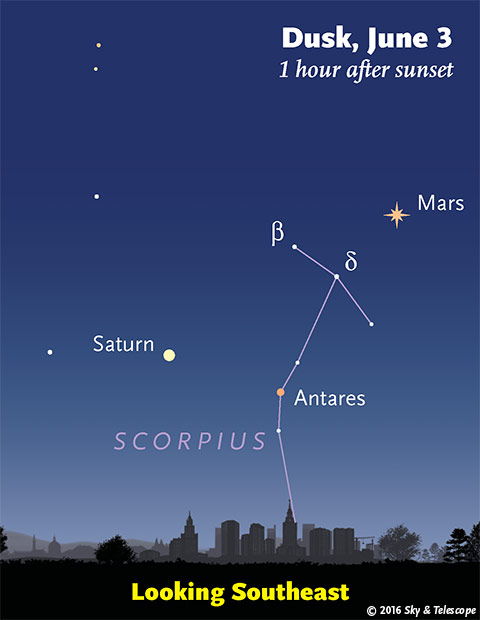
Keep watching! Mars, Saturn, and Antares continue to draw the eye southeast at nightfall. . .
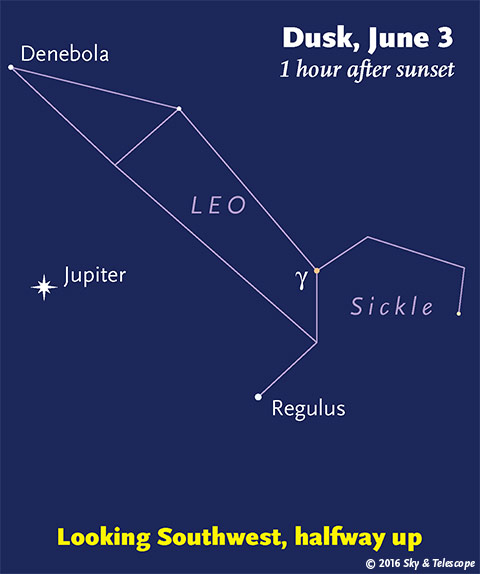
. . .while Jupiter, under the tail of Leo, sinks lower.
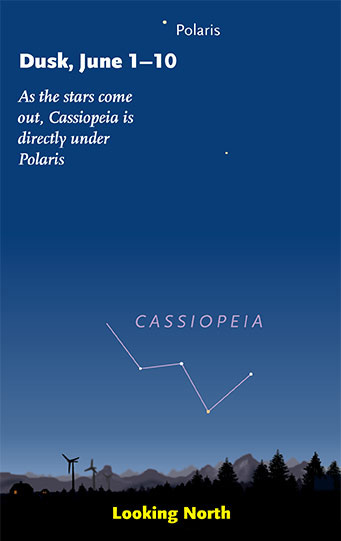
Cassiopeia inches along sideways low in the north at dusk, soon to start its long, slow climb in the northeast.
Friday, June 3
• The Mars-Antares-Saturn triangle shows a little higher at dusk every night. And it's changing shape, as Mars stretches westward away from the head of Scorpius. Mars will continue this westward (retrograde) motion until the end of June. Then it will start to slingshot back eastward, to fly right between Antares and Saturn on August 23rd and 24th.
Saturday, June 4
• On June evenings, Cassiopeia lurks low in the north: a wide, upright W, as shown below. The farther north you are the higher it'll appear, but even as far south as San Diego and Atlanta it's completely above the horizon.
• New Moon (exact at 11:00 p.m. EDT). A new lunar month begins. Unlike a calendar month, which averages 30.437 days long, a lunar month (from one new Moon to the next) averages 29.531 days. So, on average, you see the Moon in the same phase about 1 day earlier every month by the calendar.
Sunday, June 5
• For much of the spring at mid-northern latitudes, the Milky Way lies right down out of sight all around the horizon. But watch the east now. The rich Cepheus-Cygnus-Aquila stretch of the Milky Way starts rising up across the eastern sky late these nights, earlier and higher each week.
Monday, June 6
• Is your sky dark enough for you to see the Coma Berenices star cluster naked-eye? As soon as twilight is completely over, look above Jupiter by about 25°, about two and a half fists at arm's length. The cluster is dim but big, at least 5° wide, the size of a golf ball at arm's length. Its brightest stars, near its middle, form a sort of inverted Y shape. Binoculars will be a big help.
Tuesday, June 7
• As darkness arrives these evenings, look south about halfway between Jupiter and Mars. One star there stands out: Spica, in Virgo. High above it shines brighter Arcturus in Bootes. Half as far to Spica's lower right is the constellation Corvus, the Crow, eyeing Spica to steal it from Virgo's hand.
Wednesday, June 8
• With June well under way, the Big Dipper has swung around to hang down by its handle high in the northwest during evening. The middle star of its handle is Mizar, with tiny little Alcor right next to it. On which side of Mizar should you look for Alcor? As always, on the side facing Vega! Which now shines in the east-northeast.

Watch the Moon stepping past Regulus and Jupiter.
Thursday, June 9
• Look upper left of the thick crescent Moon at nightfall for Regulus, as shown here. Upper left of Regulus by 14° shines Jupiter, much brighter.
• A 3-inch telescope will show Saturn's biggest and brightest moon, 8.5-magnitude Titan. Tonight it's east of Saturn, by about four times the length of Saturn's rings. Can you see its orange tint?
Friday, June 10
• This evening's Moon poses partway between Jupiter to its upper left and fainter Regulus to its right, as shown here.
• Turn binoculars or a telescope on Jupiter, and you'll find 5th-magnitude Chi Leonis some 0.1° to its north, looking like an out-of-place Galilean satellite.
Saturday, June 11
• The first-quarter Moon shines fairly close to Jupiter this evening (about 4° to Jupiter's left). But looks are deceiving! Jupiter is 40 times larger in diameter than the Moon, and it's currently 2,100 times farther away in the distance.
_________________________
Want to become a better astronomer? Learn your way around the constellations. They're the key to locating everything fainter and deeper to hunt with binoculars or a telescope.
This is an outdoor nature hobby. For an easy-to-use constellation guide covering the whole evening sky, use the big monthly map in the center of each issue of Sky & Telescope, the essential guide to astronomy.
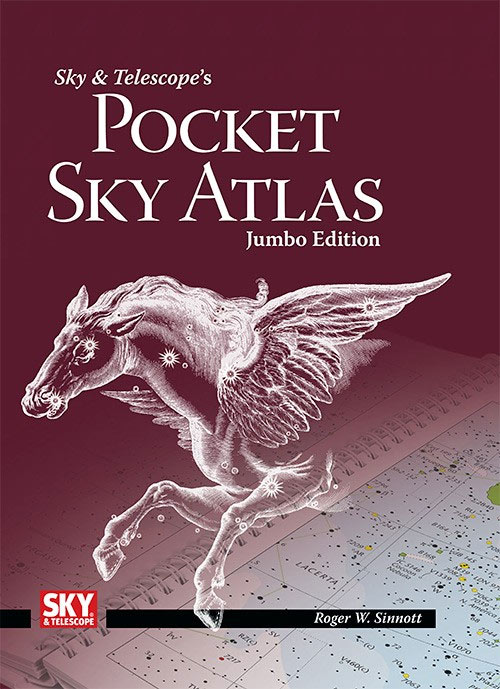
The Pocket Sky Atlas plots 30,796 stars to magnitude 7.6 — which may sound like a lot, but it's less than one per square degree on the sky. Also plotted are many hundreds of telescopic galaxies, star clusters, and nebulae. Shown above is the new Jumbo Edition for easier reading in the night. Click image for larger view.
Once you get a telescope, to put it to good use you'll need a detailed, large-scale sky atlas (set of charts). The basic standard is the Pocket Sky Atlas (in either the original or new Jumbo Edition), which shows stars to magnitude 7.6.
Next up is the larger and deeper Sky Atlas 2000.0, plotting stars to magnitude 8.5, nearly three times as many. The next up, once you know your way around, is the even larger Uranometria 2000.0 (stars to magnitude 9.75). And read how to use sky charts with a telescope.
You'll also want a good deep-sky guidebook, such as Sue French's Deep-Sky Wonders collection (which includes its own charts), Sky Atlas 2000.0 Companion by Strong and Sinnott, or the bigger Night Sky Observer's Guide by Kepple and Sanner.
Can a computerized telescope replace charts? Not for beginners, I don't think, and not on mounts and tripods that are less than top-quality mechanically (meaning heavy and expensive). And as Terence Dickinson and Alan Dyer say in their Backyard Astronomer's Guide, "A full appreciation of the universe cannot come without developing the skills to find things in the sky and understanding how the sky works. This knowledge comes only by spending time under the stars with star maps in hand."
This Week's Planet Roundup

On June 1st, ten days after Mars's opposition and one day after its closest approach, Christopher Go used his planetary-imaging setup and 14-inch scope to take this image of Syrtis Major almost dead center, at 13:59 UT. (South is up.) He is in the Philippines, on the opposite side of the world from the Americas, so our best Mars observing times are about 12 hours out of sync with his. Mars rotates in 24 hours 37 minutes, remarkably similar to Earth's rotation period. So during the week or so that the Philippines see this very marked-up side of Mars, we see the opposite, duller side of it at our best observing times.
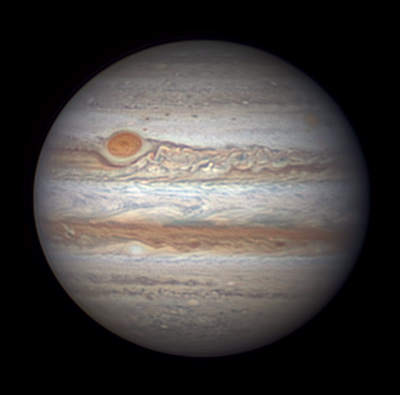
Jupiter as imaged by Christopher Go on May 15th. South is up. The Great Red Spot remains vivid. Dark material lines the Red Spot Hollow.
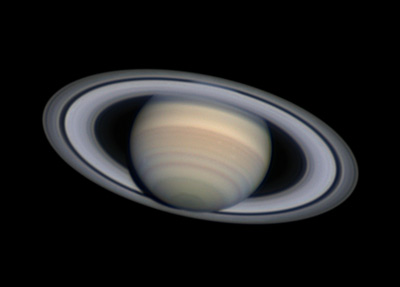
Saturn's rings are wide open this season, tipped 26° to our line of sight and extending above the planet's north and south poles. Damian Peach took this image with a 14-inch Schmidt-Cass on March 19th. South is up.
Mercury (about magnitude +0.5) is having a very poor apparition in the dawn. You can use binoculars to try for it very low, a little left of due east, 20 or 30 minutes before your local sunrise time.
Venus is out of sight, in superior conjunction with the Sun.
Mars is still at its closest to Earth in a decade (it was exactly closest on May 30th). It's the bright yellow-orange thing (magnitude –1.9) low in the southeast during evening, shining at the head of Scorpius. Mars was at opposition on May 22nd; it gets a little higher each evening. After dark, yellow Mars shines as brightly as white Jupiter in the southwest.
At dusk, look lower left of Mars by about 14° for Antares, then upper left of Antares by 7° for brighter Saturn. The Mars-Antares-Saturn triangle stands highest in the south around midnight daylight-saving time, when the planets are likely to appear sharpest in a telescope.
Mars shrinks just a trace this week, from 18.6 to 18.3 arcseconds in diameter. See our telescopic guide to Mars, with map, in the April Sky & Telescope, page 48, or the version online. And set our Mars Profiler for your time and date. If you're ambitious and have a big scope, now's the time to hunt Phobos and Deimos, the two tiny Martian moons, using the June Sky & Telescope, page 48.
Jupiter (magnitude –2.0, in southern Leo) stands high in the southwest during twilight. It moves to the lower left as the evening progresses. See our telescopic guide to Jupiter in the March Sky & Telescope, page 48.
Saturn (magnitude 0.0, in southern Ophiuchus) is barely past its June 2nd opposition. Look to Saturn's lower right for fainter Antares. See our telescopic guide to Saturn in the June Sky & Telescope, page 48.
Uranus (magnitude 5.9, in Pisces) is barely emerging from the glow of dawn low in the east.
Neptune (magnitude 7.9, in Aquarius) is fairly well up in the southeast just before dawn begins.
__________________________
All descriptions that relate to your horizon — including the words up, down, right, and left — are written for the world's mid-northern latitudes. Descriptions that also depend on longitude (mainly Moon positions) are for North America.
Eastern Daylight Time (EDT) is Universal Time (UT, UTC, or GMT) minus 4 hours.
__________________________
“This adventure is made possible by generations of searchers strictly adhering to a simple set of rules. Test ideas by experiments and observations. Build on those ideas that pass the test. Reject the ones that fail. Follow the evidence wherever it leads, and question everything. Accept these terms, and the cosmos is yours.”
Offer : Flat 25% Off on all Prescription Medicines & 15% on OTC products
Coupon Code : 1MGOMG25
Affiliate URL : https://linksredirect.com/?pub_id=11719CL10653&url=https%3A//www.1mg.com
Valid till : 30th June,2016
Terms and conditions
Minimum cart value of Rs.2000
Maximum discount of Rs.500
Delhi - NCR, Chennai, Agra, Indore, Hyderabad, Lucknow, Bhopal, Bengaluru, Jaipur, Kolkata & Ahmedabad

No comments:
Post a Comment